您现在的位置是:主页 > news > 网页设计top/快速提高网站关键词排名优化
网页设计top/快速提高网站关键词排名优化
![]() admin2025/5/21 7:26:40【news】
admin2025/5/21 7:26:40【news】
简介网页设计top,快速提高网站关键词排名优化,网页设计培训班学校排名,做甜品台的网站ELK专栏之ES索引-04索引Index入门为什么我们要手动创建索引?索引管理创建索引查询索引修改索引删除索引定制分词器默认分词器修改分词器的位置定制自己的分词器type底层结构及弃用原因type是什么?ES中不同的type存储机制type弃用的原因定制动态映射&…
ELK专栏之ES索引-04
- 索引Index入门
- 为什么我们要手动创建索引?
- 索引管理
- 创建索引
- 查询索引
- 修改索引
- 删除索引
- 定制分词器
- 默认分词器
- 修改分词器的位置
- 定制自己的分词器
- type底层结构及弃用原因
- type是什么?
- ES中不同的type存储机制
- type弃用的原因
- 定制动态映射(dynamic mapping)
- 定制动态映射(dynamic mapping)策略
- 自定义动态映射(dynamic mapping)策略
- 定义自己的dynamic mapping template(动态映射模板)
- 零停机重建索引
- 生产实践,基于alias对client透明切换index
索引Index入门
为什么我们要手动创建索引?
● 在生产上,我们需要自己手动建立索引和映射,是为了更好的管理索引,就像数据库的建表数据一样。
索引管理
创建索引
● 创建索引的语法:
PUT /index
{"settings":{...},"mappings":{"properties":{...}},"aliases":{"default_index":{}}
}
示例:
● 创建索引:
PUT /my_index
{"settings": {"number_of_shards": 1,"number_of_replicas": 1},"mappings": {"properties": {"field1":{"type": "text"},"field2":{"type": "text"}}},"aliases": {"default_index": {}}
}
插入数据:
PUT /my_index/_doc/1
{"field1":"java","field2":"js"
}
查询数据:
GET /my_index/_doc/1
GET /default_index/_doc/1
查询索引
语法:查询索引:
GET /index
语法:查询索引中的映射信息
GET /index/_mapping
示例:
GET /my_index
GET /my_index/_mapping
GET /my_index/_settings
修改索引
语法:
PUT /index/_settings
{"index" : {"number_of_replicas" : 5}
}
示例:修改副本分片数
PUT /my_index/_settings
{"index" : {"number_of_replicas" : 5}
}
删除索引
语法:删除索引
DELETE /index
语法:删除多个索引
DELETE /index1,index2
DELETE /index*
语法:删除全部索引(危险)
DELETE /_all
示例:删除索引
DELETE /book
示例:删除多个索引
DELETE /book,my_index
示例:
DELETE /book*
示例:删除所有索引
DELETE /_all
为了安全起见,防止恶意删除索引,删除的时候必须指定索引名,我们可以在elasticsearch.yml中配置action.destructive_requires_name: true。
定制分词器
默认分词器
● 分词器有三个组件,分别为:character filter,tokenizer和token filter。
● 默认的分词器是:standard 分词器。
● standard tokenizer:以单词边界进行切分。
● standard token filter:什么都不做。
● lowercase token filter:将所有字母都转换为小写。
● stop token filter(默认被禁用):移除停用词,比如a、the、it等等。
修改分词器的位置
● 启用english停用词token filter:
PUT /my_index
{"settings": {"analysis": {"analyzer": {"es_std":{"type":"standard","stopwords":"_english_"}}}}
}
使用标准分词器测试分词:
GET /my_index/_analyze
{"analyzer": "standard", "text": "a dog is in the house"
}
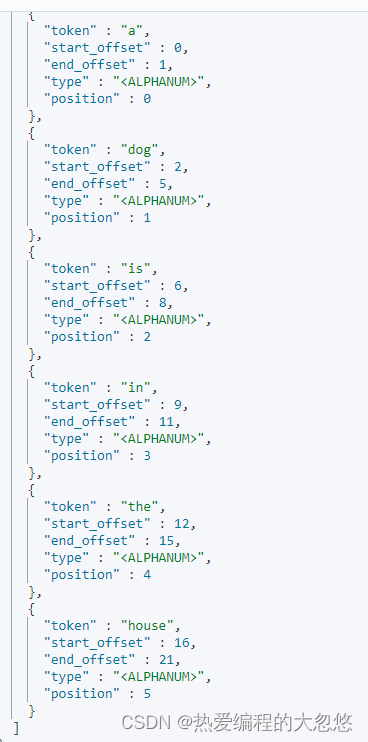
使用english停用词测试分词:
GET /my_index/_analyze
{"analyzer": "es_std","text":"a dog is in the house"
}
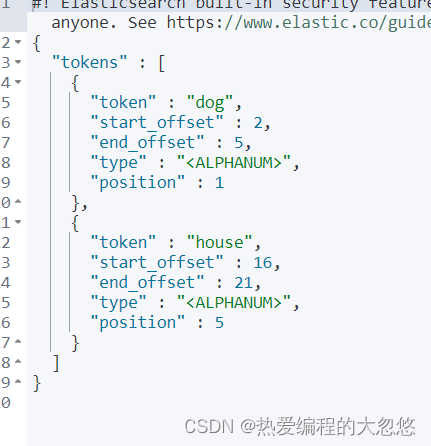
定制自己的分词器
● 定制自己的分词器:
PUT /my_index
{"settings": {"analysis": {"char_filter": {//&替换为and"&_to_and": {"type": "mapping","mappings": ["&=> and"]}},"filter": {//停用词--遇到这些词语会忽略分词"my_stopwords": {"type": "stop","stopwords": ["the", "a"]}},"analyzer": {//自定义分词器"my_analyzer": {"type": "custom",//字符过滤器"char_filter": ["html_strip", "&_to_and"],//以单词边界进行切分"tokenizer": "standard",//再进行过滤"filter": ["lowercase", "my_stopwords"]}}}}
}
测试自定义分词器:
GET /my_index/_analyze
{"analyzer": "my_analyzer","text": "tom&jerry are a friend in the house, <a>, HAHA!!"
}
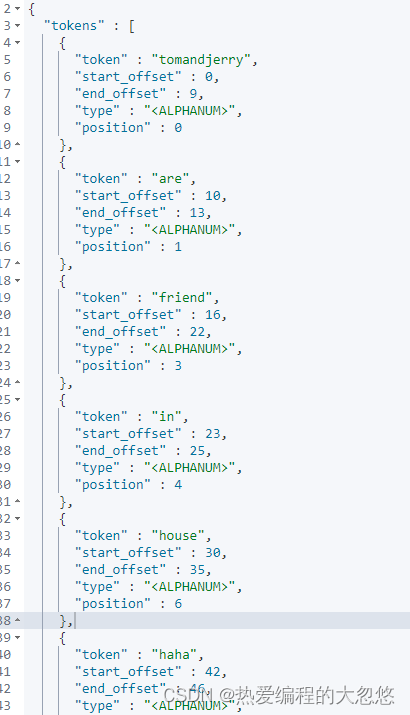
设置字段使用自定义分词器:
PUT /my_index/_mapping/
{"properties": {"content": {"type": "text","analyzer": "my_analyzer"}}
}
type底层结构及弃用原因
type是什么?
● type是一个Index中用来区分类似的数据的。这些类似的数据,可能有不同的fields,而且有不同的属性来控制索引和分词器的建立。
● field的value,在底层的Lucene中建立索引的时候,全都是opaque bytes类型,是不区分类型的。
● Lucene是没有type的概念的,在document(文档)中,实际上是将type作为document(文档)的field来存储的,即_type,ES通过_type来进行type的过滤和筛选。
ES中不同的type存储机制
● 一个Index中的多个type,实际上是放在一起存储的,因此同一个Index下,不能有多个type重名,因为那样是无法处理的。
● 比如:创建索引:
{"goods": {"mappings": {"electronic_goods": {"properties": {"name": {"type": "string",},"price": {"type": "double"},"service_period": {"type": "string"} }},"fresh_goods": {"properties": {"name": {"type": "string",},"price": {"type": "double"},"eat_period": {"type": "string"}}}}}
}
插入数据:
PUT /goods/electronic_goods/1
{"name": "小米空调","price": 1999.0,"service_period": "one year"
}
PUT /goods/fresh_goods/1
{"name": "澳洲龙虾","price": 199.0,"eat_period": "one week"
}
ES文档在底层的存储是这个样子的:
{"goods": {"mappings": {"_type": {"type": "text","index": "false"},"name": {"type": "text"}"price": {"type": "double"}"service_period": {"type": "text"},"eat_period": {"type": "text"}}}
}
那么插入的数据在底层的数据存储格式:
{"_type": "electronic_goods","name": "小米空调","price": 1999.0,"service_period": "one year","eat_period": ""
}
{"_type": "fresh_goods","name": "澳洲龙虾","price": 199.0,"service_period": "","eat_period": "one week"
}
type弃用的原因
● 同一个索引下,不同type的数据存储其他type的field的大量空值,会造成资源浪费。
● 所以,不同类型的数据,要放在不同的索引中。
● ES9中,将彻底删除type。
定制动态映射(dynamic mapping)
定制动态映射(dynamic mapping)策略
语法:
PUT /index
{"settings": {...},"mappings": {"dynamic": "xxx","properties": {"filed1": {"type": ""},"filed2": {"type": "","dynamic": "xxx"},...}},"aliases": {"default_index": {}}
}
dynamic:
- true,遇到陌生字段,就进行dynamic mapping,会自动帮助我们创建映射。
- false:新检测到的字段将被忽略。这些字段将不会被索引,因此将无法搜索,但仍将出现在返回的源字段中。这些字段不会添加到映射中,必须显示的添加新字段。
- strict:遇到陌生字段,就报错。
● 示例:
● 创建索引
PUT /my_index
{"mappings": {"dynamic": "strict","properties": {"title": {"type": "text"},"address": {"type": "object","dynamic": "true"}}}
}
测试插入数据
PUT /my_index/_doc/1
{"title": "my article","content": "this is my article","address": {"province": "guangdong","city": "guangzhou"}
}

如果是false情况下,content陌生字段不会被索引,我们在进行全局搜索时,不会搜索到content字段,但是如果搜索别的字段,搜索到该条记录时,还是会携带返回content字段的。

查询my_index的底层mapping映射,也可以发现其中并没有为content字段建立映射。
GET /my_index/_mapping
{"my_index" : {"mappings" : {"dynamic" : "false","properties" : {"address" : {"dynamic" : "true","properties" : {"city" : {"type" : "text","fields" : {"keyword" : {"type" : "keyword","ignore_above" : 256}}},"province" : {"type" : "text","fields" : {"keyword" : {"type" : "keyword","ignore_above" : 256}}}}},"title" : {"type" : "text"}}}}
}
自定义动态映射(dynamic mapping)策略
- ES会根据传入的值,自动推断类型。
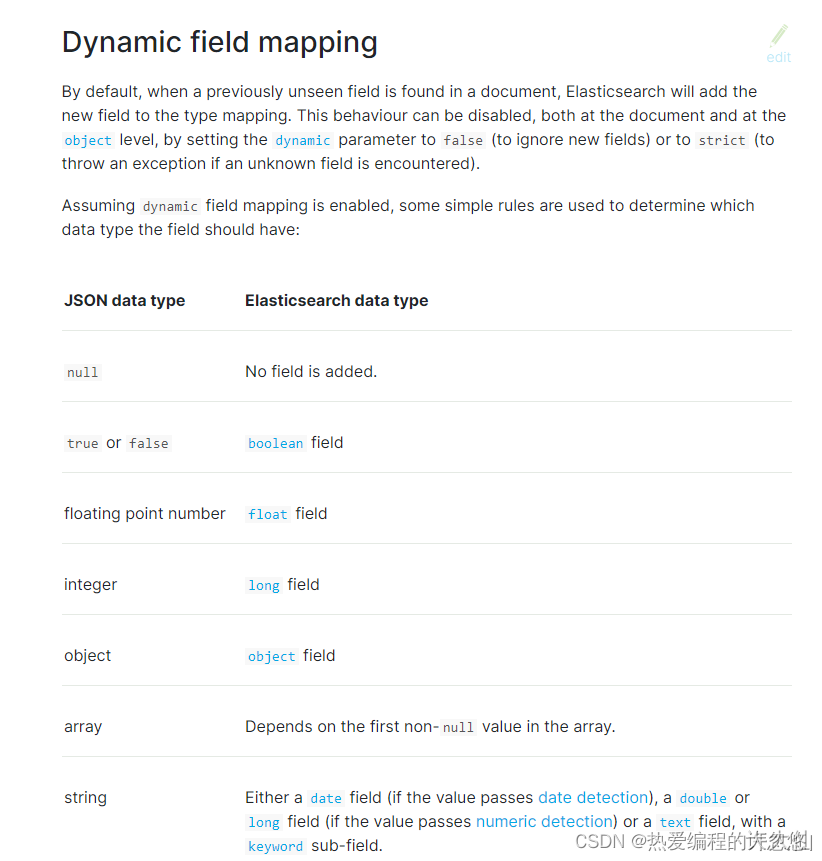
● 日期探测(Date Detection):默认会按照一定格式识别date,比如yyyy-MM-dd,但是如果某个field先过来一个"2019-11-11"的值,就会自动被dynamic mapping识别成date,后面如果在过来一个"hello world"之类的值,就会报错。可以手动关闭某个type的date detection,如果有需要,自己手动指定某个field为date类型。
● 语法:
PUT /index
{"mappings": {"date_detection": false,"properties": {"filed1": {"type": ""},"filed2": {"type": ""},...}}
}
示例:关闭日期探测
PUT /my_index
{"mappings": {"date_detection": false,"properties": {"title": {"type": "text"},"address": {"type": "object","dynamic": "true"}}}
}
测试插入数据:
PUT /my_index/_doc/1
{"title": "my article","content": "this is my article","address": {"province": "guangdong","city": "guangzhou"},"post_date":"2019-09-10"
}

● 自定义日期格式:dynamic_date_formats可以定制自己的格式。
● 语法:
PUT /index
{"mappings": {"dynamic_date_formats": ["MM/dd/yyyy"],"properties": {"filed1": {"type": ""},"filed2": {"type": ""},...}}
}
示例:自定义日期格式
PUT /my_index
{"mappings": {"dynamic_date_formats": ["MM/dd/yyyy"]}
}
测试插入数据:
PUT /my_index/_doc/1
{"create_date": "09/25/2019"
}
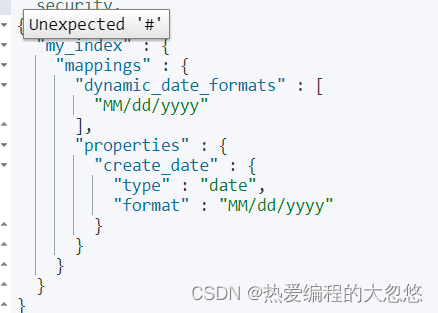
● 数字探测(Numeric Detection):虽然JSON支持本机浮点和整数数据类型,但是某些应用程序或语言有时候可能将数字呈现为字符串。通常正确的解决方案是显示的映射这些字段,那么就可以启用数字检测(默认情况下禁用)来自动完成这些操作。
● 语法:
PUT /index
{"mappings": {"numeric_detection": true,"properties": {"filed1": {"type": ""},"filed2": {"type": ""},...}}
}
示例:开启数字探测
PUT /my_index
{"mappings": {"numeric_detection": true}
}
测试插入数据:
PUT /my_index/_doc/1
{"my_float": "1.0", "my_integer": "1"
}
定义自己的dynamic mapping template(动态映射模板)
● 动态映射模板允许我们自定义映射,这些映射可以应用到动态添加的字段。
● 语法:
PUT index
{"mappings": {"dynamic_templates": [{"template_name": {... match conditions ..."mapping": { ... }}},...]}
}
- template_name:模板名称可以是任何字符串。
- match conditions:匹配条件,包括match_mapping_type、match、match_pattern、unmatch、path_match、path_unmatch。
- mapping:匹配字段应该使用的映射。
● 示例:
● 定制自己的映射模块:
PUT /my_index
{"mappings": {"dynamic_templates": [{ "en": {"match": "*_en", "match_mapping_type": "string","mapping": {"type": "text","analyzer": "english"}} }]}
}
插入数据:
PUT /my_index/_doc/1
{"title": "this is my first article"
}
PUT /my_index/_doc/2
{"title_en": "this is my first article"
}
搜索:
GET /my_index/_search?q=article
GET /my_index/_search?q=is
title没有匹配到任何的动态模块,默认就是standard分词器,不会过滤掉停用词,像is会进入到倒排索引,用is来搜索是可以搜索到的。
title_en匹配到了动态模块,就是english分词器,会过滤掉停用词,is这种停用词会被过滤掉,用is来搜索是搜索不到的。
模板写法:
PUT my_index
{"mappings": {"dynamic_templates": [{"integers": {"match_mapping_type": "long","mapping": {"type": "integer"}}},{"strings": {"match_mapping_type": "string","mapping": {"type": "text","fields": {"raw": {"type": "keyword","ignore_above": 256}}}}}]}
}
模板参数:
"match": "long_*",
"unmatch": "*_text",
"match_mapping_type": "string",
"path_match": "name.*",
"path_unmatch": "*.middle",
"match_pattern": "regex",
"match": "^profit_\d+$"
● 动态模块的应用场景:
● ①结构化搜索:
○ 默认情况下,ElasticSearch将字符串字段映射为带有子关键字字段的文本字段。但是,如果只对结构化内容进行索引,而对全文检索不感兴趣,则可以仅将字段映射为关键字。注意:为了能够搜索这些字段,必须搜索索引的时候用完全相同的值。
{"strings_as_keywords": {"match_mapping_type": "string","mapping": {"type": "keyword"}}
}
● ②仅搜索:
○ 如果只关系字符串字段的全文检索,并且不打算对字符串字段进行聚合、排序或精确搜索,可以将其映射为文本字段。
{"strings_as_text": {"match_mapping_type": "string","mapping": {"type": "text"}}
}
● ③norms :不关心评分。
○ norms是指标时间的评分因素。如果不关心评分,比如:不按评分对文档进行排序,则可以在索引中禁用这些评分因子的存储以便节省一些空间。
{"strings_as_keywords": {"match_mapping_type": "string","mapping": {"type": "text","norms": false,"fields": {"keyword": {"type": "keyword","ignore_above": 256}}}}
}
零停机重建索引
● 场景:index被确定以后,一个field的设置是不能被修改的,如果要修改一个field,应该重新按照新的mapping,建立新的index,并将数据批量查询出来,重新用bulk api写入到index中。
● 批量查询的时候,建议采用scroll api,并且采用多线程并发的方式来重建索引数据,每次scroll就查询执行日期的一段数据,交给一个线程即可。
示例:
①一开始,依据动态映射(dynamic mapping)插入数据,但是不小心有些数据是诸如"2019-11-11"之类的日期
格式,所以会被映射为date类型,实际上它是string类型。
PUT /my_index/_doc/1
{"title": "2019-11-11"
}
PUT /my_index/_doc/2
{"title": "2019-11-12"
}
②当后期向索引中插入string类型的title值的时候,会报错。
PUT /my_index/_doc/3
{"title": "this is my first article"
}
报错:
{"error" : {"root_cause" : [{"type" : "mapper_parsing_exception","reason" : "failed to parse field [title] of type [date] in document with id '3'. Preview of field's value: 'this is my first article'"}],"type" : "mapper_parsing_exception","reason" : "failed to parse field [title] of type [date] in document with id '3'. Preview of field's value: 'this is my first article'","caused_by" : {"type" : "illegal_argument_exception","reason" : "failed to parse date field [this is my first article] with format [strict_date_optional_time||epoch_millis]","caused_by" : {"type" : "date_time_parse_exception","reason" : "Failed to parse with all enclosed parsers"}}},"status" : 400
}
③此时,想修改title的类型,是不可能的:
PUT /my_index/_mapping
{"properties":{"title":{"type":"text"}}
}
报错:
{"error" : {"root_cause" : [{"type" : "illegal_argument_exception","reason" : "mapper [title] cannot be changed from type [date] to [text]"}],"type" : "illegal_argument_exception","reason" : "mapper [title] cannot be changed from type [date] to [text]"},"status" : 400
}
④此时,唯一的办法,就是重建索引,即重新建立一个新的索引,将旧索引的数据查询出来,再导入新的索引。
⑤如果说就索引的名字是old_index,新索引的名字是new_index。终端Java应用已经在使用old_index操作了,难道我们需要停止Java应用,修改使用的index为new_index,再重新启动Java应用?这个过程中,必然会导致Java应用停机,可用性也降低。
⑥给索引起一个别名,Java应用指向这个别名,那么此时Java应用指向的是旧索引。
PUT /my_index/_alias/prod_index
⑦创建新的Index,调整title的类型为string:
PUT /my_index_new
{"mappings": {"properties": {"title": {"type": "text"}}}
}
⑧使用scroll api将数据批量查询出来:
GET /my_index/_search?scroll=1m
{"query": {"match_all": {}}, "size": 1
}
返回:
{"_scroll_id" : "FGluY2x1ZGVfY29udGV4dF91dWlkDXF1ZXJ5QW5kRmV0Y2gBFnRRN1doOHVhUktXQllGZGlHRjN3bFEAAAAAAAANOhZzenoyWWlMd1I2T1kyMWtzMDExYVl3","took" : 0,"timed_out" : false,"_shards" : {"total" : 1,"successful" : 1,"skipped" : 0,"failed" : 0},"hits" : {"total" : {"value" : 1,"relation" : "eq"},"max_score" : 1.0,"hits" : [{"_index" : "my_index","_type" : "_doc","_id" : "1","_score" : 1.0,"_source" : {"title" : "2019-11-11"}}]}
}
⑨采用bulk api将scoll查出来的一批数据,批量写入新索引:
POST /_bulk
{ "index": { "_index": "my_index_new", "_id": "1" }}
{ "title": "2019-11-11" }
⑩反复循环8~9,查询一批批数据出现,采用bulk api将每一批数据批量写入到新索引。
⑪将prod_index这个alias切换到my_index_new上,Java应用会直接通过index别名使用新的索引中的数据,Java应用程序不需要停机,高可用。
POST /_aliases
{"actions": [{ "remove": { "index": "my_index", "alias": "prod_index" }},{ "add": { "index": "my_index_new", "alias": "prod_index" }}]
}
⑫直接通过pro_index别名查询:
GET /prod_index/_search
生产实践,基于alias对client透明切换index
对索引进行别名操作:
PUT /my_index_v1/_alias/my_index
● Java客户端对别名(my_index)进行操作。
● 重建索引后,切换v1到v2:
POST /_aliases
{"actions": [{ "remove": { "index": "my_index_v1", "alias": "my_index" }},{ "add": { "index": "my_index_v2", "alias": "my_index" }}]
}








